
by NITIN SETHI & KUMAR SAMBHAV SHRIVASTAVA
New Delhi; Article14: About a week after Prime Minister Narendra Modi ordered the world’s largest lockdown on 24 March 2020, India’s leading medical research body told the government that the shutdown would have limited impact on the spread of the Coronavirus, preventing only 20-25% of infections that might eventually be detected at the peak of the pandemic.
This effect would be “temporary” unless the government took other scientifically recognised measures to curtail the pandemic, the government was informed.
Never made public, the information was based on an internal assessment carried out by the Indian Council of Medical Research (ICMR), the government’s premier agency of doctors, epidemiologists and other experts, tasked with addressing the Coronavirus outbreak, which claimed 652 lives and infected 19,818 by 22 April 2020.
“Generalised transmission to be obvious in coming days,” said Vinod K Paul, one of the government’s top advisors on the pandemic, in a presentation to government, based on the ICMR assessment, and reviewed by Article14.
A member of Niti Aayog, the government’s official think tank, Paul was referring to what the government calls “community transmission”, the unrestrained spread of the virus through the general population, which, contrary to expert views (here and here), the government denies.
By Modi’s own admission, the lockdown has caused “economic hardship”, “pain and suffering”, particularly for the poor, but it would, at best, reduce the peak number of infections on a given day by 40%, according to Paul’s presentation, and buy time to prepare for measures the government had largely ignored until then (as the second part of this series will show).
The graphs in the ICMR study, on which Paul’s presentation was based, showed the lockdown would not have much impact on the likely cumulative number of infections in India.
“Best use of lock down is preparedness for” the measures, such as house-to-house screening and scaling up quarantine for those showing symptoms in affected communities, said Paul during the course of the presentation. These measures would substantially reduce the number of cases detected when the pandemic peaked and reduce infections as the pandemic wore on, Paul indicated.
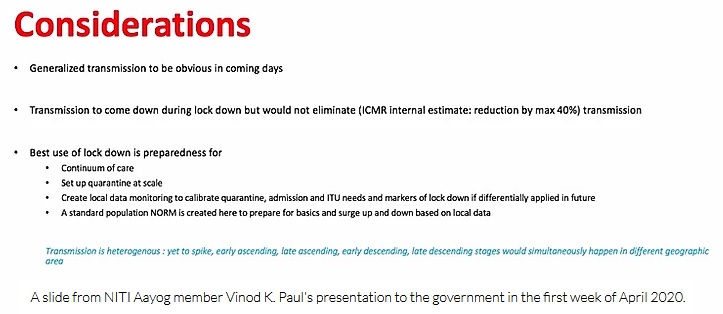 From the time the government agreed, he said, a week would be required to “prepare for planning and data collection” to give “results before lockout finishes (sic) to give indication of national and district-specific numbers”.
From the time the government agreed, he said, a week would be required to “prepare for planning and data collection” to give “results before lockout finishes (sic) to give indication of national and district-specific numbers”.
To screen large numbers of people across the country with fever and cough, Paul’s presentation suggested, the government would require to ensure:
-
Door-to-door supply of food and essential items to the poor.
-
That each district measure the presence of COVID-19 and monitor infection trends.
-
“Fast reporting” to identify and quarantine infective clusters.
-
Central quarantines for those living in densely populated areas, such as slums, and others at home.
-
A rapid increase in intensive-care units and hospital beds for peak-infection periods.
Paul’s estimation of ventilators and hospital beds required implied that India was unprepared, by early April, for the scale of Covid-19 infections that scientists predicted despite a lockdown.
Paul indicated that setting up medical facilities to cater to the rising number of infections would take longer. He displayed a calculation that said for “daily infection in an area is 500”, the government would require 150 ventilators, 300 intensive care beds and 1,200-6,000 beds.
Yet, Paul’s presentation was a partial picture, based as it was on another presentation that the ICMR had drawn up from its research. The Council’s research offered a grimmer prognosis.
‘Large-Scale Transmission With Devastating Numbers’
"Generalized large-scale transmission is inevitable with devastating numbers spaced by time and location."
That was the prediction the ICMR made and highlighted in the draft presentation that Paul eventually used to advise the government. ICMR’s draft presentation was also sent to Paul during the first week of April.
The 40% reduction in peak Covid-19 infections that the lockdown could deliver was theoretical, said the ICMR assessment. In practise, the lockdown would likely reduce cases by only 20-25%, concluded the ICMR experts.
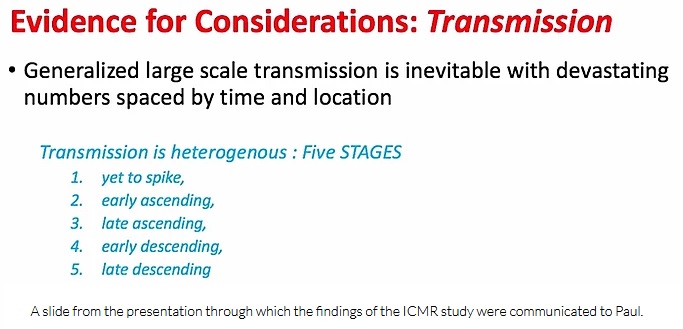
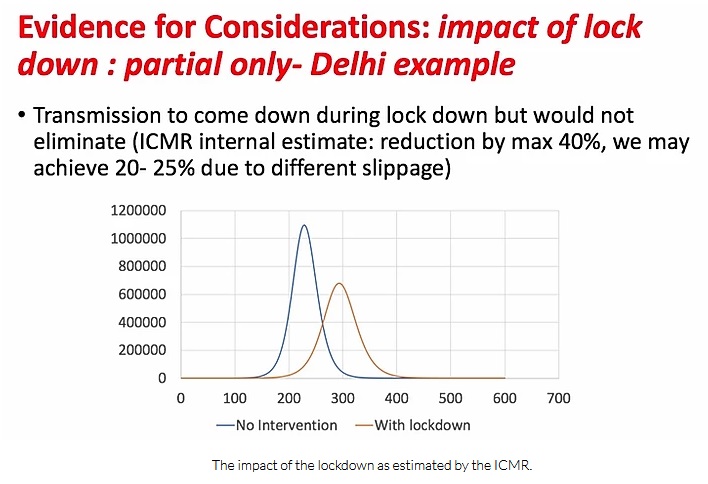
These assessments contradict government statements on the success of the 21-day lockdown, now extended to 3 May 2020. On 14 April, Modi said: “When we had only 550 Corona cases, then itself India had taken the big step of a 21-day complete lockdown. India did not wait for the problem to aggravate. Rather, we attempted to nip the problem in the bud itself, by taking quick decisions as soon as it arose.”
Article14 sent detailed queries to Paul, the health ministry and the ICMR. We followed the emails with reminders and messages over more than 48 hours. No one responded. This story will be updated if and when they do.
On 11 April the health ministry released a graph to the media suggesting the lockdown had been a success.
The lockdown and containment measures had limited Covid-19 cases to 7,477 by 10 April instead of 208,000, the health ministry said, or 3.60% of what it might have been.
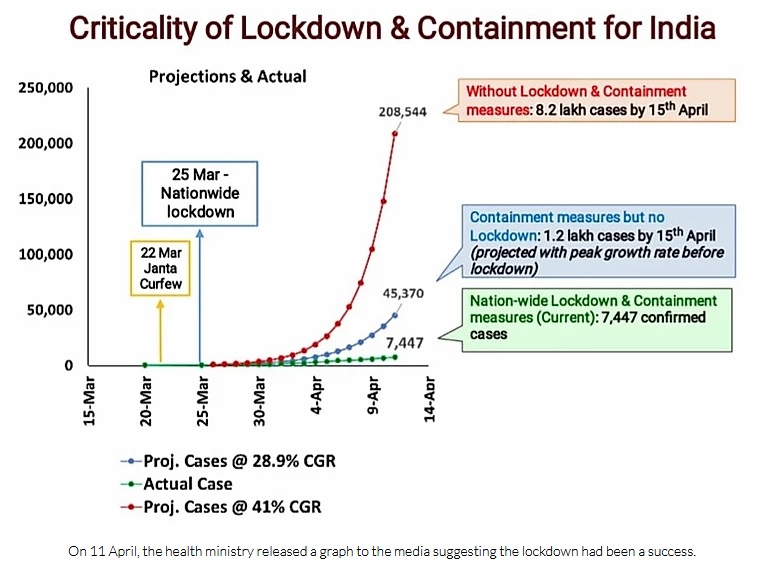
The calculation on the graph was not attributed, and, experts said, did not account for the fact that India had one of the lowest levels of testing for Covid-19 patients globally.
“The government numbers were not worth reading into because our testing rates were so poor, and up to mid April, symptomatic patients without a contact history were excluded from testing," said T Sundararaman, former executive director of the National Health Systems Resource Centre and former dean of the School of Health System Studies at the Tata Institute of Social Sciences.
Indeed, as the testing rates of the government improved late in the day, the number of hotspots and containment zones rose in metropolitan cities, such as Delhi and Mumbai, which together account for over a fourth of Covid-19 infections nationwide.
A week into the lockdown, on 31 March, the government also claimed before the Supreme Court: “It was found medically desirable and advisable to declare a national lockdown to ensure complete social distancing and breaking the chain [of virus infection]. This decision was taken after detailed and careful deliberations with the Expert Group and after considering all possible eventualities and options in detail.”
With limited testing of potentially infected people, minimal surveillance of potential hotspots, the government continued to insist the infection continued to spread through only limited “local transmission”, a stage at which the spread is low enough to trace all those infected and their source of infection, primarily from abroad.
What ICMR Recommended
“Absent any other control measure, lifting the lockdown would allow a resurgence of transmission,” the ICMR’s draft internal presentation said. These measures include collecting data from across the country, carrying out surveillance through bi-weekly visits to homes, and large-scale quarantine for those showing Covid-19 symptoms.
Extrapolating from infection data of Delhi to explain how the lockdown would impact the spread of Covid-19 nationwide, the ICMR said 1.3 million could be infected despite a 21-day lockdown.
The lockdown would delay peak infection, the ICMR assessment said: Without a lockdown, daily infections would peak between 100-150 days from the first reported infection; with a lockdown, the peak would come within 150-200 days.
The number of infections nationwide would, eventually, be the same. The disease would spread for over a year, the study shows.
Modi extended the lockdown on 14 April. Lockdown extensions would have weaker “wave” effects on peak infections and would be “challenging to implement”, the ICMR assessment said.
“So far the only mechanism known to prevent transmission is earliest quarantine,” said the assessment, referring to quarantine of not just those detected to be Covid-19 positive after tests but also of those showing symptoms of the disease - something the government did have in place.
The ICMR scientists recommended controlling virus transmission by “a community-based test-and-quarantine strategy”. They recommended quarantine for every second symptomatic person within 48 hours and for three of every four symptomatic persons, within four days of showing symptoms.
So far, the government had only attempted to quarantine those who tested positive for Covid-19 or those who voluntarily reached hospitals with the symptoms. The ICMR scientists were recommending large-scale surveillance and increased testing through a door-to-door campaign and quarantine for all those found symptomatic.
In other words, they said, the lockdown was not the route to “break the chain”, as the government had claimed on 24 March.
Based on the ICMR conclusions, Paul’s advice was that the lockdown had only bought the government time. It should use the opportunity to set up testing and hospital facilities required to run what he termed a “continuum of care”. The larger objective of this set of actions, his presentation said, was to try and quarantine every second symptomatic person within 48 hours.
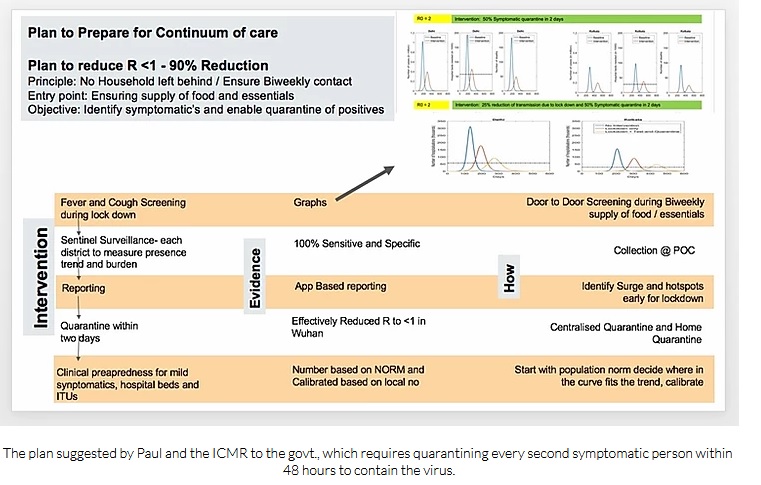
So far, the lockdown has been enforced by coercive, often heavy-handed, police action, criticised for its four-hour notice, stranding thousands of migrants, who found themselves without jobs or food.
That testing and quarantine is a more effective method than lockdown has now been proven in research by another set of independent scientists.
But, to quarantine every second symptomatic person within 48 hours of detection would require a complete change of strategy. Screening, surveillance, testing and quarantining would have to be scaled rapidly to unprecedented levels, Paul’s advice indicated.
In public, the government, including the Prime Minister, claimed it was prepared. “Had India not undertaken holistic (sic) and integrated approach and in time not taken decisions speedily one gets goosebumps thinking what would be the situation in the country,” said Modi on 14 April, as he extended the lockdown. “From past experience, it is clear, the route we have chosen, in today’s situation, that is the right route. The country has had a great advantage from the lockdown and social distancing...India has more than 1 lakh (100,000) beds. More than 600 hospitals are ready.”
This is the first of a two-part series. Read the second part here.
This article was originally published in Article14.
*Opinions expressed in this article are the author's own and do not necessarily reflect the views of UMMnews.
www.article-14.com is a coalition of journalists and lawyers focussed on the rule of law in India.




